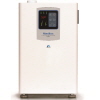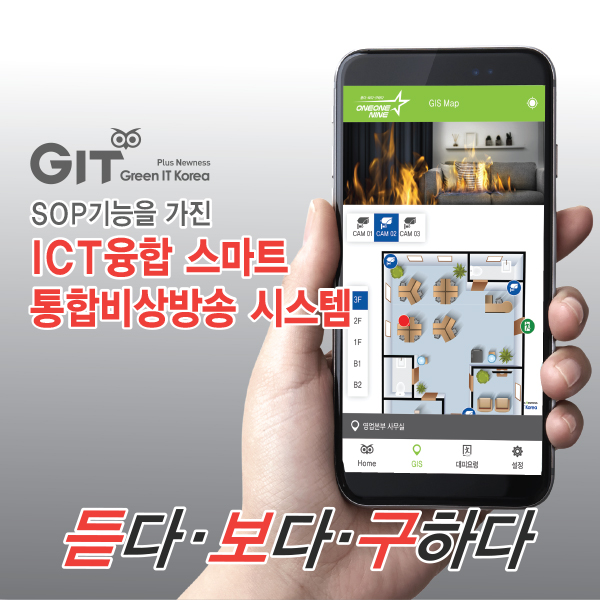[Introduction]
Equipment that configures logic (firmware) with physical hardware to prevent hacking by hardware filtering even if a modified non-standard protocol is entered and designed for intruding the internal network and maintaining unidirectionality of image data between networks.
① Raw Image (RAW) data extraction function for secure area transmission control server input network image data
② Simultaneous implementation of physical network separation and inter-manganese data transfer functions through unidirectional transmission of raw data between secure area transmission control server and non-secure area transmission control server
③ Implementing web standard service of real-time image data for standard image service under the Non-Security Area Public Data Service Act
[Characteristic]
- 1U 4Bay Type
- TONS-F Series: 4Slot maximum 128ch with maximum 32ch support per Bay for internal network
- TONS-D Series: Up to 4ch support per Bay for external network 4Slot up to 16ch (a feature that safely shares the St-Liming image of a specific camera)
- Physically complete network separation ensures high levels of stability.
- Non OS-based, self- firmware logic eliminates OS self-security threats
- Onvif RTSP standard protocol support
- Non-active X and HTML5 standards for providing public data on video information
[Application Effect]
① Network Image Security System Network Infringement
- Securing safety of network separation through proposed technology, including information that poses a threat to the security of the nation in case of external leaks such as major industrial facilities and defense facilities, among video information of public institutions and public corporations
- Protecting the video information system by blocking external hacking and exploitation of control through one-way transmission of raw image (RAW) data to network image data.
- Securing security through physical network separation while maintaining the same operational convenience of network image security systems, such as setting up equipment control for camera networks in the same as before
② Activating the use of video data from public institutions and local governments
- Improving the quality of life through public service for public institutions' events and other events by providing safe public disclosure of public video data through the formation of a public video disclosure platform
- Reduce costs and increase efficiency of integrated control by securely sharing camera data for video security in the border areas held by local governments to create a foundation for sharing resources for video security systems operated by each institution.
- Image monitoring system data held by public institutions are highly value-added data for the utilization agencies, and public data provision/utilization is activated based on network safety secured by the proposed technology.
[Introduction]
Equipment that configures logic (firmware) with physical hardware to prevent hacking by hardware filtering even if a modified non-standard protocol is entered and designed for intruding the internal network and maintaining unidirectionality of image data between networks.
① Raw Image (RAW) data extraction function for secure area transmission control server input network image data
② Simultaneous implementation of physical network separation and inter-manganese data transfer functions through unidirectional transmission of raw data between secure area transmission control server and non-secure area transmission control server
③ Implementing web standard service of real-time image data for standard image service under the Non-Security Area Public Data Service Act
[Characteristic]
- 1U 4Bay Type
- TONS-F Series: 4Slot maximum 128ch with maximum 32ch support per Bay for internal network
- TONS-D Series: Up to 4ch support per Bay for external network 4Slot up to 16ch (a feature that safely shares the St-Liming image of a specific camera)
- Physically complete network separation ensures high levels of stability.
- Non OS-based, self- firmware logic eliminates OS self-security threats
- Onvif RTSP standard protocol support
- Non-active X and HTML5 standards for providing public data on video information
[Application Effect]
① Network Image Security System Network Infringement
- Securing safety of network separation through proposed technology, including information that poses a threat to the security of the nation in case of external leaks such as major industrial facilities and defense facilities, among video information of public institutions and public corporations
- Protecting the video information system by blocking external hacking and exploitation of control through one-way transmission of raw image (RAW) data to network image data.
- Securing security through physical network separation while maintaining the same operational convenience of network image security systems, such as setting up equipment control for camera networks in the same as before
② Activating the use of video data from public institutions and local governments
- Improving the quality of life through public service for public institutions' events and other events by providing safe public disclosure of public video data through the formation of a public video disclosure platform
- Reduce costs and increase efficiency of integrated control by securely sharing camera data for video security in the border areas held by local governments to create a foundation for sharing resources for video security systems operated by each institution.
- Image monitoring system data held by public institutions are highly value-added data for the utilization agencies, and public data provision/utilization is activated based on network safety secured by the proposed technology.









